Every minute your service desk spends diagnosing routine issues is a minute lost to innovation, customer satisfaction, and operational efficiency. What if your IT systems could detect, diagnose, and fix themselves before a human even knows there’s a problem?
Welcome to the world of Agentic AI in ServiceNow, where your service desk evolves into a self-healing system—autonomous, intelligent, and built to scale. No more endless ticket queues. No more “have you tried turning it off and on again?” Just proactive IT that works.
In traditional ITSM models, service desks operate reactively—waiting for end-users to raise tickets, then scrambling to investigate and resolve issues. The result? Burnt-out agents, SLA breaches, frustrated users, and ballooning support costs.
But with Agentic AI, powered by ServiceNow’s AI Agents, AIOps, and Agent Assist, the script is flipped. These tools don’t just accelerate response times—they autonomously resolve incidents, identify emerging issues before they snowball, and continuously optimize IT operations.
Whether you’re overseeing critical systems in a hospital, managing ERP uptime in manufacturing, or defending against downtime in financial services, self-healing IT isn’t just a luxury—it’s becoming a necessity. And ServiceNow is making it possible.
What Is a Self-Healing Service Desk?
A self-healing service desk is more than automation—it’s an intelligent ecosystem that can independently detect, analyze, and resolve IT issues without human intervention.
Think of it as moving from the help desk to the health desk. Instead of reacting to a printer failure, software crash, or network slowdown only after a user complains, a self-healing system, powered by ServiceNow AI Agents and AIOps, identifies anomalies, initiates root-cause diagnostics, and triggers predefined remediation workflows in real-time.
Key Capabilities:
- Anomaly Detection – ServiceNow helps you to constantly monitor signals from logs, metrics, and events across infrastructure. It flags deviations before they impact services.
- Incident Prediction – AI models forecast high-risk issues, helping teams fix problems before they escalate.
- Automated Resolution – Integration with Agentic AI workflows enables zero-touch resolutions for common incidents like disk space alerts, app crashes, and service restarts.
- Agent Assist & Agent Workspace: For complex issues, ServiceNow’s Agent Assist surfaces knowledge articles, past resolutions, and relevant workflows directly in the Agent Workspace, enabling faster manual intervention when needed.
In short, a self-healing desk blends prediction, automation, and AI-led decision-making into one cohesive experience, freeing human agents to focus on high-impact issues, not password resets or server pings.
Real-World Use Cases of Self-Healing with Agentic AI in ServiceNow
Companies aren’t just experimenting with self-healing—they’re operationalizing it across high-stakes environments. Below are three real-world use cases across healthcare, manufacturing, and BFSI where Agentic AI in ServiceNow is creating a measurable impact.
1. Automated Incident Resolution in Healthcare IT
Problem: A large hospital group struggled with recurring service degradation across radiology and lab systems. Manual triage caused delays in patient processing, especially during peak hours.
Solution: ServiceNow AIOps was deployed to monitor system logs and performance baselines. When anomalies were detected, like abnormal memory spikes in imaging software, Agentic AI workflows triggered automated VM reboots and cache flushes, without human intervention.
Result:
- 52% reduction in mean time to resolution (MTTR)
- 30% drop in high-priority tickets
- Zero impact on patient experience during outages
2. Predictive Maintenance in Manufacturing Operations
Problem: A global electronics manufacturer was hit by unexpected machine downtime due to undetected ERP service failures and network latency.
Solution: The company integrated ServiceNow with OT sensors and SAP logs. Using ServiceNow AI Agents, they created a self-healing loop that detected workflow bottlenecks and automatically rerouted tasks or rebooted background jobs through a ServiceNow orchestrator.
Result:
- 70% fewer service disruptions per quarter
- 60% faster incident triage via Agent Assist
- Improved SLA compliance across production lines
3. Auto-Healing for Trading Platforms in BFSI
Problem: A Tier-1 bank’s trading platform had high incident volume caused by latency in API gateways and identity/authentication services. Even a 5-minute delay could result in major financial loss.
Solution: With ServiceNow Agent Workspace and AIOps, the IT team created rule-based scripts that auto-restarted failed microservices and cleared identity sync caches based on anomaly patterns.
Result:
- 80% of repeat incidents resolved without escalation
- End-user complaints reduced by 45% in Q1
- Agents now handle only high-priority, customer-facing tickets
These aren’t aspirational stories—they’re practical examples of how Agentic AI is already being used to evolve service desks from reactive to resilient, self-sustaining systems.
How to Enable a Self-Healing Desk in ServiceNow
Building a self-healing service desk with Agentic AI in ServiceNow isn’t just a plug-and-play solution. It requires careful planning, integration, and a deep understanding of your IT environment. But the payoff—greater efficiency, reduced downtime, and optimized service delivery—is well worth the effort.
Here’s how you can enable self-healing capabilities in your service desk using ServiceNow:
1. Integrate AIOps for Intelligent Monitoring and Anomaly Detection
The foundation of a self-healing service desk begins with proactive monitoring. By integrating AIOps with ServiceNow, you enable continuous monitoring of system health and performance. The AI models within AIOps analyze logs, metrics, and event data from various sources—server logs, network performance metrics, and app telemetry—to identify abnormal behavior and predict incidents.
Steps to Implement:
- Step 1: Configure ServiceNow AIOps to ingest data from your entire infrastructure, including cloud services, on-prem systems, and endpoint
- Step 2: Set up event correlation rules that automatically flag anomalies and escalate high-priority incidents.
- Step 3: Test the AI’s prediction capabilities by running simulated incidents and measuring its detection accuracy.
2. Define Auto-Remediation Workflows with Agentic AI
Once anomalies are detected, Agentic AI workflows take over. These workflows can automatically resolve issues like restarting failed services, clearing temporary files, or rebalancing system resources. For more complex issues, Agent Assist provides agents with AI-generated suggestions, knowledge articles, and automation scripts.
Steps to Implement:
- Step 1: Identify common, repetitive incidents that can be handled automatically (e.g., service restarts, disk space issues, app crashes).
- Step 2: Build automation workflows in ServiceNow Orchestration that address these incidents.
- Step 3: Train the system by feeding it real incidents to “learn” and improve the automation scripts over time.
3. Empower Your Service Desk with AI-Powered Assistants
While Agentic AI can handle the lion’s share of incidents, human agents will still need to address more complex cases. Enter ServiceNow Agent Assist: a tool designed to improve agent productivity by providing AI-powered suggestions, relevant knowledge articles, and resolution workflows right within the Agent Workspace.
Steps to Implement:
- Step 1: Deploy Agent Assist within your existing ServiceNow Agent Workspace.
- Step 2: Set up knowledge management integration to pull relevant troubleshooting articles based on the context of each ticket.
- Step 3: Train your service desk team on how to leverage these AI-driven recommendations to resolve issues faster.
4. Automate Incident Routing and Prioritization
For incidents that require human intervention, AI-driven prioritization helps by assessing severity, business impact, and urgency. ServiceNow can use these factors to route tickets to the right agents, ensuring high-priority issues are handled first.
Steps to Implement:
- Step 1 – Configure incident classification rules based on predefined service level agreements (SLAs).
- Step 2 – Set up AI-powered ticket routing that categorizes and prioritizes incidents automatically.
- Step 3 – Enable dynamic SLA tracking to keep agents focused on critical issues and avoid SLA breaches.
By following these steps, you’ll transform your traditional service desk into a proactive, self-healing powerhouse that minimizes downtime, increases agent productivity, and boosts overall user satisfaction.
Benefits of Self-Healing Service Desks with Agentic AI in ServiceNow
The shift to a self-healing model isn’t just about improving IT operations—it’s about unlocking enterprise-wide value. From CIOs focused on strategic innovation to ITSM managers tracking SLAs, the benefits of Agentic AI in ServiceNow resonate across the org chart.
1. 60% Faster Incident Resolution
With automated incident resolution workflows and AI Agents detecting and responding in real-time, you significantly reduce mean time to resolution (MTTR). No human bottlenecks. No repetitive diagnostics.
Impact: More uptime for business-critical systems, less pressure on your support teams.
2. 40–70% Reduction in Ticket Volume
By automatically resolving common issues—like service restarts, access errors, or memory leaks—self-healing desks significantly reduce L1 and L2 support loads.
Impact: Fewer tickets mean higher agent morale and more time for complex problem-solving.
3. Consistent Compliance and Audit Readiness
For regulated industries like healthcare and BFSI, automated workflows also mean consistent remediation trails, pre-configured logging, and real-time compliance checks.
Impact: Always audit-ready, with zero manual effort.
4. Increased Agent Productivity via Agent Workspace
With ServiceNow Agent Assist embedded in the Agent Workspace, service agents get contextual help, like similar past tickets or step-by-step KBs, without switching screens or second-guessing solutions.
Impact: Every agent performs at the level of your best agent.
5. Proactive Problem Management
Self-healing systems don’t just fix issues—they learn from them. Over time, your service desk becomes better at predicting and preventing incidents through AI-led insights.
Impact: Reduced recurrence, smarter systems, leaner operations.
Also Reads:
1. How ServiceNow for Manufacturing Can Cut Downtime by 40% Through Predictive Maintenance Workflows
Conclusion – From Reactive to Resilient—The Future of ServiceNow ITSM is Self-Healing
Traditional service desks are struggling to keep pace with the scale and complexity of modern IT environments. The solution is no longer more people—it’s smarter systems. With Agentic AI workflows, ServiceNow AIOps, and AI-powered Agent Assist, organizations can shift from reactive firefighting to proactive, automated service delivery.
Whether you’re managing IT for a manufacturing plant, a healthcare network, or a global enterprise, the message is the same: self-healing isn’t a luxury—it’s a necessity for uptime, compliance, and cost control.
Looking to Build a Self-Healing Service Desk?
LMTEQ can help you implement and customize Agentic AI in ServiceNow to meet your business needs. From AIOps integration to incident automation and agent enablement—we build ITSM systems that think, act, and resolve.
Get in touch to schedule a personalized ServiceNow consultation.

